
Thermal Imagery Indicates Activity at Yongbyon Nuclear Reprocessing Facilities
As featured in The New York Times “Biden Is Facing an Uneasy Truth: North Korea Isn’t Giving Up Its Nuclear Arsenal” on May 20, 2021.
Key Findings
- Recently acquired LANDSAT 7 and 8 thermal infrared imagery of the Yongbyon Nuclear Research Center provide strong indications that during March and April 2021, activity involving the heating of buildings and operations of facility support systems had resumed at several locations.
- These indications reveal clear patterns, distinct from the surrounding terrain and daily solar heating patterns, that suggest that the Radiochemistry Laboratory, its associated thermal plant, and the centrifuge plant resumed operations during the early part of March 2021 and have continued into mid-April 2021.
- Thermal patterns alone may not be able to explain the full extent of the operations by themselves, however, they may (and do in this case) provide clear evidence of operations at these locations.
- Likewise, these images provide strong indications that the IRT-DPRK reactor, 5MW(e) reactor, and the Experimental Light Water Reactor are not operating.
- As noted in our March 2021 report, this renewed activity is likely an indicator of a new reprocessing campaign designed to expand North Korea’s inventory of fissile material for nuclear weapons – a strategic political move by Kim Jong-un to continue slowly ratcheting up pressure on both the Biden administration and South Korean president Moon Jae-in, or a combination of both.
During March and April 2021, CSIS Beyond Parallel undertook an analysis of the Yongbyon Nuclear Research Center using LANDSAT 7 and 8 thermal infrared imagery.1 As a control, this analysis was compared with imagery acquired during January 2021 (see Overview of Methodology below).2 This thermal infrared imagery analysis not only supports, but also dramatically illustrates and expands upon the conclusions in our March 30, 2021 report.

Radiochemistry Laboratory: After months, if not years, of general inactivity, the Radiochemistry Laboratory is either currently engaged in a new reprocessing campaign to extract plutonium from spent reactor fuel rods and expand North Korea’s inventory of fissile material for nuclear weapons or preparing for the start of a new reprocessing campaign. This is indicated not only by the small wispy plume of steam or smoke emanating from a support building adjacent to the main reprocessing halls seen in the multispectral imagery published in our March report and an additional spectral imagery during the intervening weeks, but also by a very significant thermal (i.e., warm) pattern over the plant’s main processing halls (as opposed to support areas) observed in the March 5, 29, and April 14 thermal infrared images.
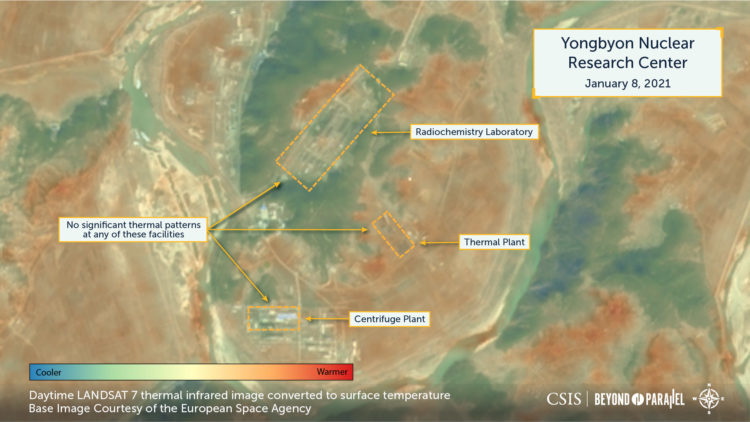
Radiochemistry Laboratory Thermal Plant: The thermal plant associated with the Radiochemistry Laboratory, which has been generally inactive for months, if not years, is now operating. This is indicated by both our previously published multispectral imagery showing a small wispy plume emanating from the plant’s exhaust stack and by the significant thermal pattern at the plant observed in the March 5, 29, and April 14 thermal infrared images.
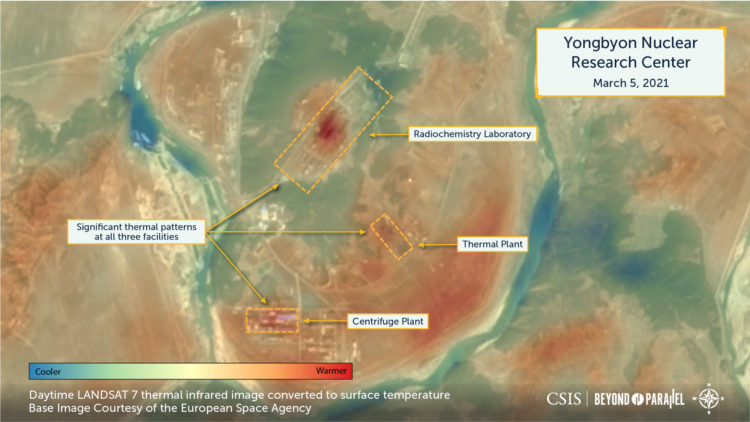
Centrifuge Plant: Although no significant activity was observed at the centrifuge plant in the multispectral imagery published in our previous report, the March 5 and 29 thermal infrared images show a significant thermal pattern at the plant on both dates, suggesting that it is operating. Notably, this thermal pattern had increased in the April 14 thermal image that suggests (but is not conclusive) of increased activity.
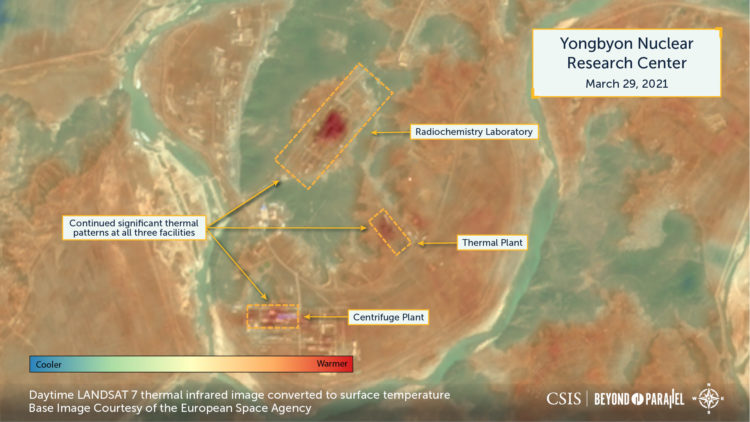
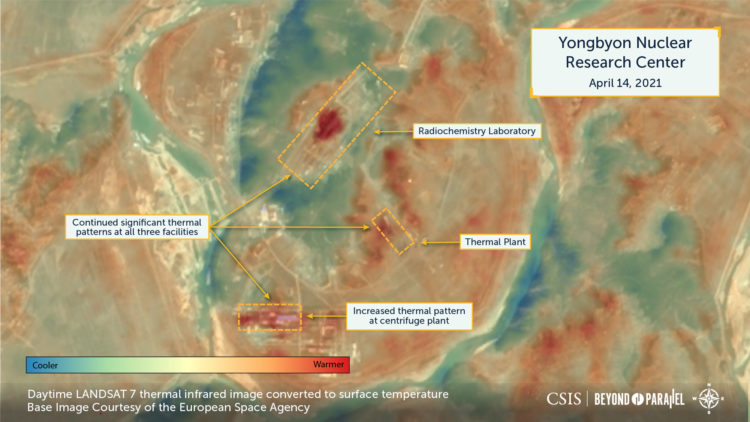
Reactors: The thermal infrared images from January, March, and April 2021 show no indications that the Experimental Light Water Reactor (ELWR), 5MW(e) Reactor, or the IRT-DPRK (a modified IRT-2000 reactor) reactor is operating. This is indicated by the lack of any significant thermal patterns at any of their locations.
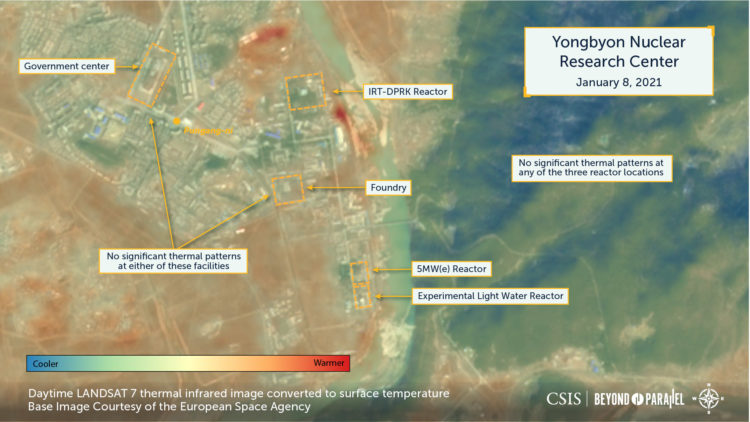
Other Activities: While not normally discussed, there are several additional facilities at the Yongbyon Nuclear Research Center that show moderate-to-significant thermal patterns in the March 5 and 29 thermal infrared images.
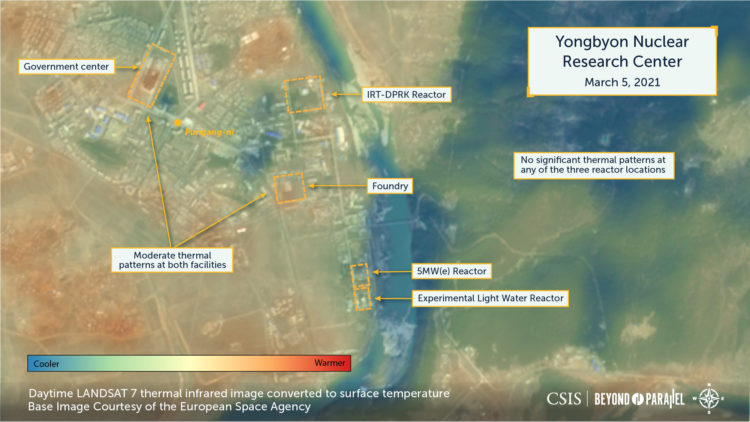
The first is a small compound that lies within the main research area northwest of the 5MW(e) reactor and southwest of the IRT-DPRK. This facility is a small foundry engaged in the production of metal and steel products for use within the Yongbyon Nuclear Research Center and associated activities. This foundry has small forges that generate tremendous heat. In thermal infrared imagery over the past 20 years, this facility has frequently displayed moderate-to-significant thermal patterns.
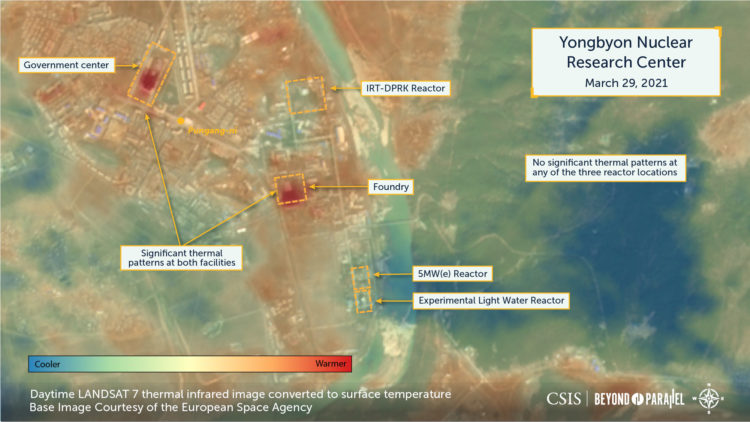
The second facility is the large building near the center of Pungang-ni, the town adjacent to the research center, and the location for its housing, social, and government buildings and activities. Built during the late-1990s to early 2000s, this building serves as the main government offices and center of community activities for the Yongbyon Nuclear Research Center and Pungang-ni. During the past 20 years, this facility has occasionally displayed moderate-to-significant thermal patterns. It is apparently being well heated this March.
The thermal image from April 14, 2021 shows several new thermal patterns in the research area. The research area’s thermal plant has a new moderate-to-significant thermal pattern indicating that it is operating; previously, it had a minimal thermal pattern indicating it was either running at minimal levels or was shut down. That it is operational is further supported by the new moderate-to-significant thermal patterns at several of the laboratory and office complexes to the north of the thermal plant that are supplied with heat from the thermal plant.

In summary, thermal imagery from March and April 2021 shows increasing levels and numbers of thermal patterns over a number of significant areas of interest at the Yongbyon Nuclear Research Center. These thermal patterns strongly suggest that a reprocessing campaign is underway, uranium enrichment at the centrifuge plant is ongoing and may have increased slightly during April, and that at least some of the laboratories and offices in the research area are operating.
Overview of Methodology
For this thermal infrared imagery report of the Yongbyon Nuclear Research Center, Beyond Parallel used moderate resolution (~100m) thermal imagery available from U.S. LANDSAT-7 and LANDSAT-8 satellites that have a combined revisit interval of approximately 8 days. Except for cloudy or hazy conditions (as was experienced on April 6), this provides an ability to collect and observe thermal patterns associated with buildings and systems that have longer thermal cycles, such as steam and heating plants, as well as buildings with sustained operations. Data from these two sensors were processed between January 8, 2021 and April 14, 2021 to determine if thermal patterns associated with nuclear operations at Yongbyon’s nuclear facilities might be detected and if they provide an indication of operations.
The collected LANDSAT thermal infrared imagery was converted to surface temperatures using techniques widely described in published remote sensing journals and routines available in many desktop software programs. These data were processed using standard procedures and then compared to each other in order to determine thermal patterns and changes.
The imagery from January shows a thermal pattern consistent with general surface heating from daily solar patterns. It shows no major heat patterns for any of the primary areas of interest. By March 8, however, clear patterns of concentrated heat existed over the Radiochemistry Laboratory, the laboratory’s thermal plant, and the centrifuge plant. On March 29, the thermal patterns for these three facilities continued, and as noted above, clear concentrated heat patterns were also observed over two additional support facilities. The April 14 image showed an increased thermal pattern over the centrifuge plant and new moderate-to-significant thermal patterns at the thermal plant in the research area and at several of the laboratory and office complexes to its north.
For the same time period, the locations for the IRT-DPRK reactor, 5MW(e) reactor, and the Experimental Light Water Reactor showed no obvious thermal patterns that would indicate operations.
References
- See: LC08_L1TP_117032_20210305_20210312_01_T1, LE07_L1TP_117032_20210329_20210329_01_RT and LE07_L1TP_117032_20210414_20210414_01_RT. An additional image acquired on March 16, 2021 by the European Space Agency was used as a reference image (S2A_MSIL2A_20210316T022551_N0214_R046_T52TBK_20210316T052343). ↩
- See: LE07_L1TP_117032_20210108_20210203_01_T1. ↩
